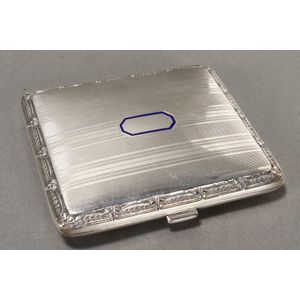EGB Enamel Cigarette Case with Butterfly Mark
Ernest Gideon Bek silver and enamel cigarette case stamped with butterfly mark and Egb, of rectangular form, with Belle Epoque border and engine turned decoration, accented with blue enamel cartouche, with gilt interior, total weight 91 cm, 8.5 x 7.5 cm
You must be a subscriber, and be logged in to view price and dealer details.
Subscribe Now to view actual auction price for this item
When you subscribe, you have the option of setting the currency in which to display prices to $Au, $US, $NZ or Stg.
This item has been sold, and the description, image and price are for reference purposes only.
- Cartouche - An ornamental panel in the form of of a shield, oval or rectangular scroll with curling edges. It may be carved into the back of a chair or the top of a sideboard, or present on a piece of silver or jewellery, and contain the initials of the original owner, heraldic symbols, or some other inscription, such as the details of a presentation.
In ceramics the term defines the central area of a vase or similar with a decorative border in one of the shapes above, into which a decorative scene or figures have been painted. - Belle Epoque - The Belle Époque, also known as the "Beautiful Era," was a period in European history that lasted from the late 19th century to the outbreak of World War I in 1914. The term is most commonly associated with France, but is also used to refer to the same period in other countries, particularly in Western Europe and Latin America.
During the Belle Époque, Europe experienced a time of great prosperity and cultural, artistic, and scientific advancements. It was an era of peace and optimism, characterized by industrial growth, urbanization, and new technologies such as electricity, automobiles, and the telephone. The period is also associated with a flourishing of art and culture, particularly in the fields of literature, music, and the visual arts. - Engine Turned - Engine turning is a decorative technique used on metal surfaces to create intricate curving or geometric pattern. The process involves cutting a series of lines into the surface of the metal using a rose engine or decoration lathe which rotates the metal as it cuts, allowing the operator to create a repeating pattern that covers the entire surface. The resulting surface has a shimmering, reflective quality that is often described as "engine turned." Where an engine turned item has been enamelled, the term used to describe the decoration is usually guilloche.
Engine turning was originally developed to decorate metal objects such as firearms, scientific instruments, and other metal objects that required precise and elegant design.
This item has been included into following indexes:
Visually similar items

A Magnus Goldring, Edwin Harrop Invicta sterling silver engine-turned cigarette case Initialled 'J.A' 178g
Sold by
in
for
You can display prices in $Au, $US, $NZ or Stg.

Enamelled sterling silver box, circa 1920s, marks of. Height Matthews, Birmingham. Length 6 cm
Sold by
in
for
You can display prices in $Au, $US, $NZ or Stg.

Silver & enamel cigarette case, stamped 925, 6 cm x 9 cm approx.
Sold by
in
for
You can display prices in $Au, $US, $NZ or Stg.

Antique continental silver snuff box, engraved decoration, marked 800. Length 8 cm, weight 78grams
Sold by
in
for
You can display prices in $Au, $US, $NZ or Stg.
